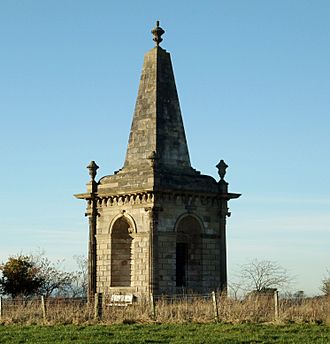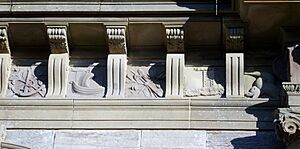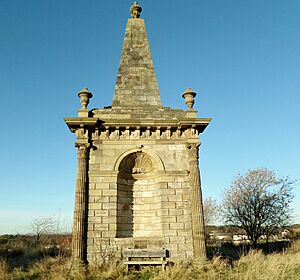Macrae Monument facts for kids
Quick facts for kids Macrae Monument |
|
|---|---|

The Macrae Monument
|
|
| Alternative names | Orangefield family burial ground |
| General information | |
| Type | Monument |
| Architectural style | Corinthian |
| Location | Monkton Hill, South Ayrshire, Scotland |
| Town or city | Monkton |
| Country | Scotland |
| Coordinates | 55°31′14″N 4°35′27″W / 55.5206°N 4.5907°W |
| Construction started | 1748 |
| Completed | 1750 |
| Client | James Macrae |
| Height | 10m |
| Technical details | |
| Structural system | Sandstone ashlar blocks |
| Design and construction | |
| Architect | John Swan |
The Macrae Monument is a tall, impressive stone structure. It stands on a hill overlooking the town of Monkton in Scotland. This monument was built for James Macrae, a very successful man. He started from a poor background. He became a sea captain and later a governor in India.
James Macrae made a huge fortune. He returned to Scotland with a lot of money. He bought a house and named it 'Orangefield'. He died in 1746 and was buried in an unmarked grave. The monument was built after his death.
Contents
The Macrae Monument: A Closer Look
This monument is built in the Corinthian style. It was constructed between 1748 and 1750. John Swan of Kilmaurs was the architect. The monument has a square base. On top of the base is an obelisk. An obelisk is a tall, narrow, four-sided tapering monument.
The monument features four shell-decorated alcoves. These are small recessed areas. Each side of the monument has carvings. These carvings might show parts of James Macrae's life. You can see dolphins, anchors, forts, and ships. Five urns sit on top, holding carved eternal flames. Some people think friends built the monument to remember James Macrae.
Building and Rebuilding the Monument
Construction began in 1748. However, a storm hit on August 13, 1749. The monument was almost finished, but it collapsed. John Swan rebuilt it in 1750. Parts of the original building were found inside the new structure.
In 1996, a part of the monument collapsed again. It was at risk of falling completely. But in 2001, it was fully restored. Many groups helped with the restoration. These included Historic Environment Scotland. The monument is now a protected building. It is a Category A listed building.
The monument used to be surrounded by trees. These trees were part of the Orangefield woodland. Some of the trees have now been cut down. A lane leads up to the monument from Whiteside Farm.
Who is Buried at the Monument?
This monument is sometimes called the 'Orangefield Family Burial ground'. During the restoration work in 2000, human remains were found. They were discovered below a chamber inside the monument. Six burials from the 1700s were found.
These included two adult males and two adult females. There were also two children. One child was estimated to be 4 to 5 years old. The other was 1 to 2.5 years old. Only two of the burials were formal. The other graves did not face east–west. This is the traditional direction for Christian burials. The bones were carefully placed back inside the monument.
The Mystery of James Macrae's Burial
There is a story about James Macrae's bones. It says that his friends moved them. They supposedly took them from Monkton churchyard. Then they reburied them inside the monument. The story says friends gathered at Orangefield House. After two days, they went to Monkton Kirk. They dug up some bones. They believed the largest skull and longest leg bones belonged to James Macrae. They then placed these bones in the monument.
Some people believe James Macrae's remains were quietly moved. This might have happened after the monument was finished. However, during the 2001 restoration, no remains of "Governor Macrae" were found. The six graves found inside the monument were from the early 1800s. This was suggested by the coffin handles.
James Macrae never married. But his sister had a son and three daughters. James left his Orangefield Estate to his niece, Macrae McGuire. She married Charles Dalrymple. The estate was later sold to pay off debts. James Macrae had many relatives in Ayrshire. It is possible some of them were buried at the Orangefield Family Burial Site.
Interesting Facts About James Macrae
James Macrae greatly admired William III. He paid for a large statue of William of Orange. This statue cost £3,000. It stands in Glasgow today. It was originally on Argyle Street. Now it is in Cathedral Square.
An old map from 1828 shows the Macrae Monument. It is called an 'Obelisk' on the map. It looks the same then as it does now. The map shows it on the lands of Orangefield.
A group of buildings near the monument is called 'Corsehill'. This name might mean a Christian cross once stood on the hill. Similar names are found in other places.
James Macrae is also said to have helped the City of Glasgow. He loaned them a lot of money. This helped them pay a tax. The tax was put on them by Charles Edward Stuart, also known as Bonnie Prince Charlie.
James Dalrymple of Orangefield was a close friend of the famous poet Robert Burns.



